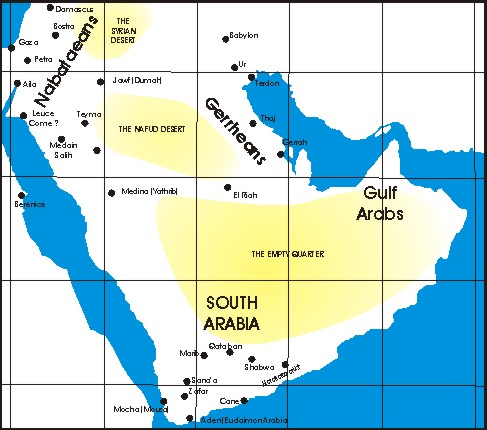Many of us are familiar with the ancient story of Abraham and his desire to have a son. In the Biblical account of his story, Abraham first had a son with his ‘handmaiden’ Hagar. This first-born son was named Ishmael. Abraham’s second son, Isaac, was declared the ‘son of promise.’ The Jews today claim decent from Abraham through this second son, Isaac. Few people today know what happened to the descendants of Ishmael. It is often assumed that they simply became the Arabs of the Middle East, but to most of us, our knowledge stops there.
It appears that Hagar may have had more children than Ishmael. Several scholars have suggested that she later remarried and had children who became known as the Hagarites. The Biblical record tells us that during the time of King Saul, Saul fought with the Hagarites who were living east of Gilead. This would place them in the hills near Amman Jordan, or perhaps farther east in the desert. It appears they migrated from this location to present day Iraq because they are mentioned later in the Assyrian records.
The great historian W.W. Muller proposed that a city of the people of Hagar would have become “han-Hagar,” or possibly “Hagara,” when written in Aramaic. When Helenized it would have become “Gerrha.” H. von Wissmann proposed that the word “Hagar” itself could be used to describe a walled city with towers and bastions. Based on these ideas, archeologists have speculated that the east Arabian kingdom of the Gerrhaeans can be recognized as the descendants of Hagar. If this is true, then history has much more to tell us of the Hagarites, who would have been known as the Gerrhaeans in the Greek world.
Hagarites in Babylon
One of the earliest mentions of these people is found in a poem written in the third century BC by Nicander of Colophon. He refers to the “*nomads of Gerrha and those who plough their fields by the Euphrates*” (A.S.F. Gow and A.F. Scholfield, Nicander, The poems and Poetical Fragments, (Cambridge, 1952), 111). Subsequently, there is little mention of the nomadic Gerrhaeans in Chaldaean and Assyrian records. The historian F. C. Movers suggested in 1856 that it might have been Nebuchadnezzar who exiled the nomadic Gerrhaeans from Mesopotamia as part of a policy to protect his empire from menacing Arab tribes. (F. C. Movers, Das phonizische Alterthum, (Berlin, 1856), iii. 308).
H.G. Rawlinson dated the Chaldaean exodus to the Neo-Assyrian period. He suggested that after Sennacherib had exterminated the Chaldaeans in 694 BC he expelled a number of people to Gerrha. This would have included the “nomads of Gerrha.” (H. G. Rawlinson, Intercourse between Indian and the Western World from the Earliest Times to the Fall of Rome, (Cambridge, 1926).
Most historians, however, believe the nomads of Gerrha were expelled during the reign of Achaemenids. Two dates have been suggested: the first would have been during the fall of the Chaldaeans to Achaemenids (A.H. L. Heeren, A manual of Ancient History, (Oxford, 1833); A.W. Stiffe, “Ancient Trading Centres of the Persian Gulf, iii: Pre-Mohammedan Settlements”, GJ9 (1897). The second would have been later at some point in the Achaemenid period (Kennedy, The Early Commerce of Babylon, 271). Kennedy believed that the Gerrhaeans left Babylon after Darius I retook the city in 488 BC. Alternatively, C. F Shiwek suggested that the expulsion of the Gerrhaeans took place during the reign of Xerxes. This would have been as a result of the brutal repression that resulted from Megabyzus’ revolt in Babylon around 482 BC (Der Persische Golf, 64). M. Amer suggested that because the Gerrhaeans are not mentioned by Herodotus, their exodus from Babylon would have taken place at a much later date (Amer, M., The Ancient Trans-Peninsular Routes of Arabia, 135).
Some years later, during the time that Strabo wrote his history, the Gerrhaeans had earned fame as merchants of incense. Strabo 16.4.19 recorded: “from their trafficking both the Sabaeans and the Gerrhaeans have become richest of all (the Arabians). “ Strabo also recorded in 16.3.3: “The Gerrhaeans import most of their cargo on rafts to Babylonia and thence sail up the Euphrates with them, and then convey them by land to all parts of the country,” and, “*the Gerrhaeans traffic by land for the most part, in the Arabian merchandise and aromatics…*”
Agatharchides (200-131 BC) recorded: “*…Sela and Palestine where the Gerrhaeans and Minaeans and all the Arabs who live in the region bring incense from the highlands, it is said, and their aromatic products.*”
Juba (25 BC - 25 AD) and later Pliny (AD 77)records: “For this trade (with Elymais and Marmania) they opened the city of Carra (Gerrha) where their market was held. For they all used to set out on the twenty-day march to Babba and Syria-Palestine. According to Juba’s report, they began later for the same reason to go to the empire of the Parthians. It seems to me that still earlier they brought their goods to the Persians rather than to Syria and Egypt,” which Herodotus confirms, who says “the Arabs paid 1,000 talents of incense yearly to the kings of Persia.” (NH 12.40.80)
Gerrha
The location of Gerrha has long been a mystery, and many scholars have guessed at its location. In 1990, D.T. Potts, in his two-volume series entitled The Arabian Gulf in Antiquity, suggested that Gerrha would have been located in the region of the modern port of al-Jubayl in eastern Saudi Arabia (D.T. Potts, The Arabian Gulf in Antiquity: Volume II: From Alexander the Great to the Coming of Islam, (Oxford: Clarendon Press, 1990). He bases this on Strabo’s description that Gerrha was located two hundred stadia from the sea, and 2,400 stadia from Teredon, which would have been located near modern day Basra. It is Potts’s suggestion that there was both a city of Gerrha and a port of Gerrha and that they were located some twenty miles apart.

Map of Arabia
The Hagarites and the Sons of Ishmael.
The Hagarites are also mentioned in the Bible in I Chronicles 5:10, 19-20 and Psalm 83:6. The account in I Chronicles 5:10 tell us: “*in the days of Saul they made war with the Hagarites, who fell by their hand, and they dwelt in their tents throughout all the land east of Gilead.*” It was the opinion of Dr. C. I. Scofield that the use of the word Hagarites, in this case, refers to the tribes of the sons of Ishmael in general and not to a specific group of people (Notes in the New Scofield Reference Bible, (Oxford University Press, 1967).
A few verses later the Biblical account tells us: “And they made war with the Hagarites, with Jetur, and Naphish and Nodab. And they were helped against them, and the Hagarites were delivered into their hand, and all who were with them; for they cried to God in the battle, and he was entreated by them because they put their trust in him. And they took away their cattle, of their camels fifty thousand, and of sheep to hundred and fifty thousand, and of asses, two thousand, and of men a hundred thousand. For there fell down many slain, because the war was of God. And they dwelt in their stead until the captivity.” (I Chronicles 5:19-22)
This passage can be taken in two ways. It can be understood that King Saul fought with the Hagarites, as well as with the tribes of Jetur, Naphish and Nodab. On the other hand, it can be understood that King Saul fought with the Hagarite tribes of Jetur, Naphish and Nodab. If the latter was true, then it may be that there was no new specific group of people known as Hagarites, but that this term simply refers to the tribes of the sons of Ishmael.
The other Biblical reference to the Hagarites seems to fly in the face of this reasoning. In Psalm 83, Asaph the songwriter records for us several the enemies of the Jews. He mentions: “the temples of Edom, the Ishmaelites, Moab and the Hagarenes, Gebal, Ammon, Amalek, the Philistines with the inhabitants of Tyre; Assyria also is joined with them, they have the children of Lot”(Psalm 83:6-8). In this list, the Hagarenes appear to be separate from the Ishmaelites. There can be several explanations for this. The Hagarenes may not be the Hagarites. Or, Asaph the poet may have been using poetical license when writing this Psalm. Since he was interested in rhythm and meter, he may have needed another enemy to add to his list, and so he would have split the tribes of Ishmael into two. On the other hand, some of the tribes of Ishmael may have been known as Hagarites, and some as Ishmaelites. Whatever his reason, Asaph makes specific mention of two groups of people: Hagarenes and Ishmaelites.
Interestingly enough, Muslim scholars and historians have no record of any descendants of Hagar, other than the 12 sons of Ishmael. Their view of the history of the tribes of Arabia is illustrated in the following chart.

Chart of the founding tribes of Arabia
Keohane, Alan, Bedouin, Nomads of the Desert, Kyle Kathi Ltd., London, 1994
Conclusion
To date, no one has sufficiently solved the mystery of the Hagarites. Did Hagar remarry and have children which became known as the Hagarites, or descendants of Hagar? Or did the children of Ishmael become known as Hagarites? We know from history that the tribes of Ishmael were nomads. The Biblical record places the Hagarites in the desert east of the Holy Land, over toward Babylon. In the third century BC Nicander of Colophon mentioned the ‘nomads of Gerrha,’ and places them along the shores of the Euphrates river. Later, the entire eastern coast of Arabia appears to have been given the name Gerrha. While it is impossible to be completely certain, we tend to believe that the Hagarites, and subsequently the Gerrhaeans (their Greek name), refer to the twelve tribes that came from Ishmael, the progeny of Hagar. It is very probable that the Jews simply referred to them as the descendants of Hagar, lumping together Ishmael’s children and any other children that Hagar may have had. In the male dominated culture of the Middle East, it is doubtful that a tribe would call itself after a female descendant. The Jews, however, may have done this in a derogatory manner.




















Page Discussion
Membership is required to comment. Membership is free of charge and available to everyone over the age of 16. Just click SignUp, or make a comment below. You will need a user name and a password. The system will automatically send a code to your email address. It should arrive in a few minutes. Enter the code, and you are finished.
Members who post adverts or use inappropriate language or make disrespectful comments will have their membership removed and be barred from the site. By becoming a member you agree to our Terms of Use and our Privacy, Cookies & Ad Policies. Remember that we will never, under any circumstances, sell or give your email address or private information to anyone unless required by law. Please keep your comments on topic. Thanks!